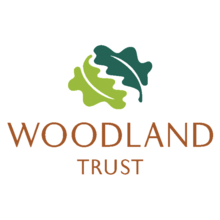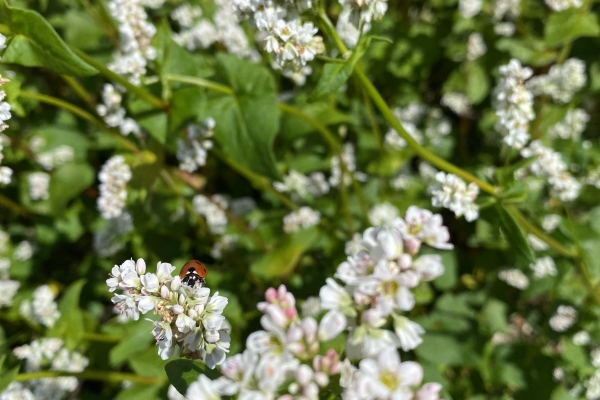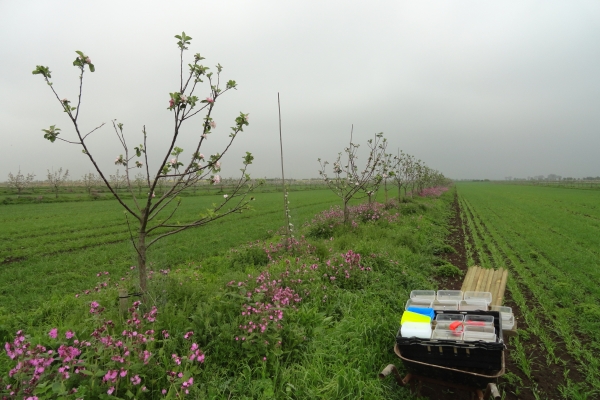We’re a 450-acre (ac) / 182-hectare (ha) farm in Screveton looking down on the Vale of Belvoir, east of the Trent Valley. The farm has been in the family since 1933 and is still a family business currently run by myself, third generation farmer David Rose. My grandfather came to our farm in 1933 – it was then a 90-ac (36-ha) small mixed farm, with arable and milking cows, and we would pick fruit from local trees to sell in the market. We gradually expanded and at 200 ac (81 ha) I realised we were going to struggle to create a profitable way of farming. I managed to persuade some other local farmers to join us on what was by then an all-arable farm. I found myself questioning our intensive way of farming and began looking for alternative approaches. I looked to diversify the business, including a mixed enterprise with cereals and sheep, and the creation of an edible woodland for the local community.
On the back of being involved with LEAF, Sustain and CPRE, and through my Nuffield Farming Scholarship, I was really interested in the whole aspect of environmental management of the farm and involving local communities, schools etc. We now farm using minimum tillage, direct drilling, reducing pesticides, and follow the LEAF model. I have realised that big or small, the margins aren’t really going to be that different, and if you’re not enjoying what you’re doing, you may as well not be farming. Our environmentally sustainable farming practices, with less dependency on chemical pesticides and fertilisers, and an emphasis on soil health and care, mean that the farm is more wildlife friendly. Our mixed farming system creates a diverse base for wildlife, and the RSPB and FWAG have monitored increasing numbers of birds and animals.
Our farm model – a partnership approach
The farm is now a hub for lots of different partnerships and enterprises – arable, agroforestry, and livestock. Our arable enterprise is a joint venture with the nearby Samworth Farms Ltd. They help with the arable crops – wheat, barley, beans…We supply wheat for flour for the Small Food Bakery.
I am a Woodland Trust Advocate and host agroforestry research on the farm – there are two main trial areas on the farm; silvoarable – apple trees and elderflower etc within a block of arable land, and silvopastoral – sheep grazing within an edible woodland area.
Our livestock comprises native breeds of about 150 sheep, which includes some heritage Hebridean sheep looked after by a shepherdess, and a small number of English Longhorn cattle, and we adopt high standards of environmental practice and animal welfare. The sheep enterprise is a joint venture with a young guy who wants to set up in farming (and helps with lambing).
Education, health and wellbeing on the farm
I set up FarmEco to educate and inform people about the working countryside and to reconnect people to the land and the environment. It is a very active farm with lots of people involved, sharing ideas. Generally, it’s about looking back at the old systems and using modern technology and innovation to make those systems work. It acts as an opportunity for people to interact with rural farming life, understand more about sustainable food production, and work together to widen food and farming partnerships, and enables the delivery of practical land-based activities that aim to significantly improve the lives of individuals and local communities.

So, we have a working farm, but we also have a community enterprise business as well. We rent some of the land to a group of local people who set up FarmEco Community Care. It enables people of all ages from local rural and inner-city communities, from all sectors of society and with differing needs and abilities, to benefit from improvements in their physical health and mental wellbeing. It also seeks to influence behavioural change as people develop a greater understanding and appreciation of rural life, the environment and agroforestry. Engagement includes the development of skills in growing, processing and selling farm produce, and monitoring biodiversity.
As part of our enterprise stacking objective, we host a wide variety of health and wellbeing focused businesses in our specially built pods on site. These include a hairdresser, chiropractor, masseuse, woodworking group (Screveton Sheds), and counselling service.
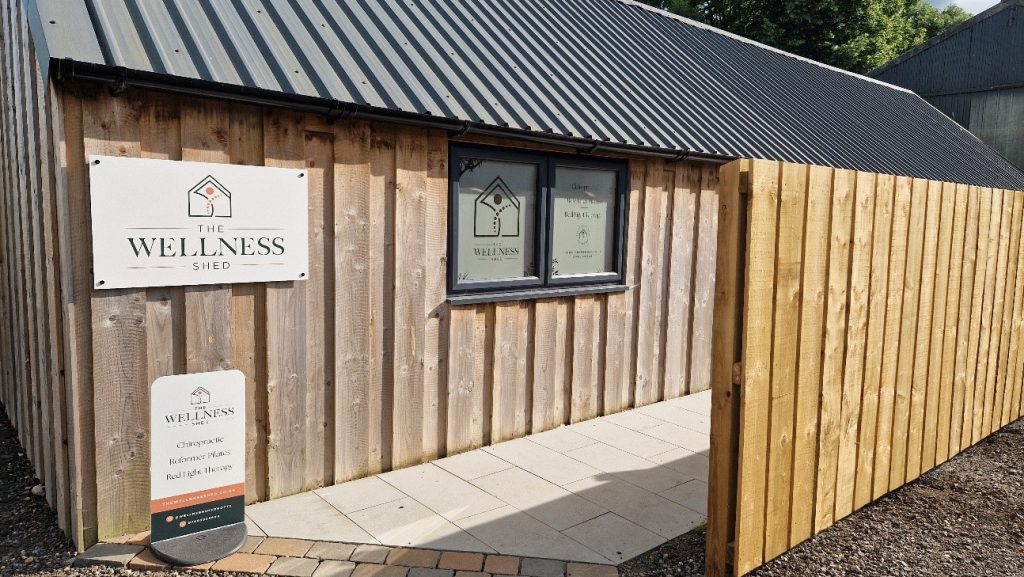
We also have a cycling café and fitness gym. They all benefit from the facilities on the farm – for example there is a 3.5-mile nature walk the gym and café both use. The aim is to create a fully holistic approach to health on the farm, by valuing all the social, physical and environmental aspects that contribute towards our sense of wellbeing.
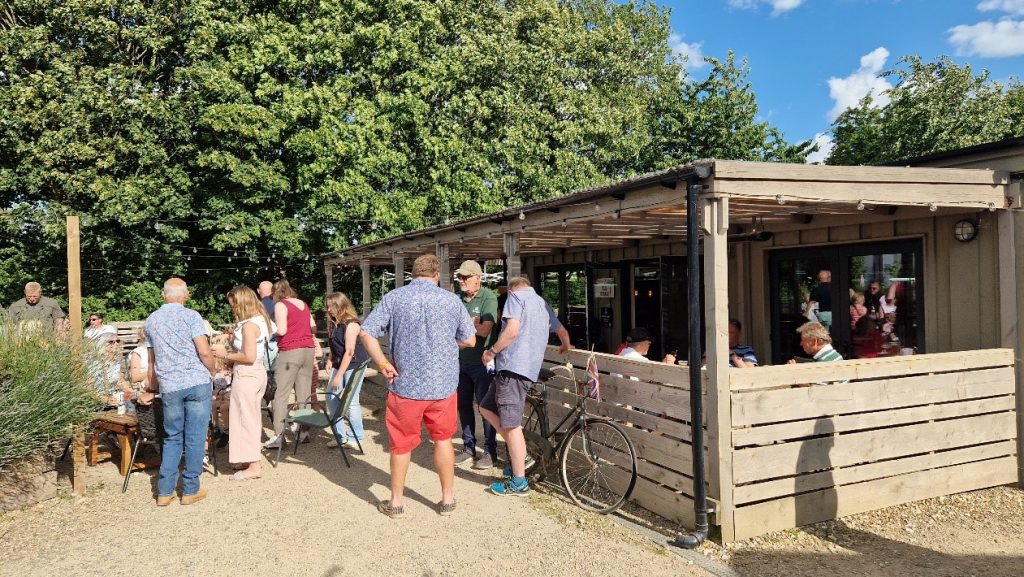
The team at FarmEco
FarmEco has three directors who help oversee the running of the organisation alongside myself. They are Lil Hammond, Ann Dean, and David Walker. Each bring a wealth of skills and experience to the role which is incredibly valuable.
James Thompson, Environmental Scientist and Conservation Manager, has been involved with FarmEco since 2020, supporting the strategic and sustainable development and conservation plans for the farm and is heavily involved with the agroforestry. After 26 years in retail, James took the decision to do something more worthwhile. He has always had a passion for the environment and began an Environmental Science degree (part time) in January 2019 with the aim of being involved in environmental programmes that make a difference by supporting the community, environment, whilst making economic sense.
Sustainability in practice
Agroforestry
By planting trees and increasing the biodiversity, we have been able to completely phase out the use of artificial pesticides. We began the farm’s organic conversion in 2022 and are now close to achieving certification, which is a fantastic achievement, demonstrating the power of agroforestry as a pest-control tool.
Agroforestry adds value to the farm in many different ways – being part of our ‘enterprise stacking’ (the sum of all the smaller elements), is important, but at the same time, and equally important, is looking at it from an environmental stewardship and a community point of view (our mission at FarmEco is to reconnect people to land and the environment) – all three elements are very important.
In addition to the trial agroforestry areas, the farm had already established woodland and hedgerows, utilising marginal land.
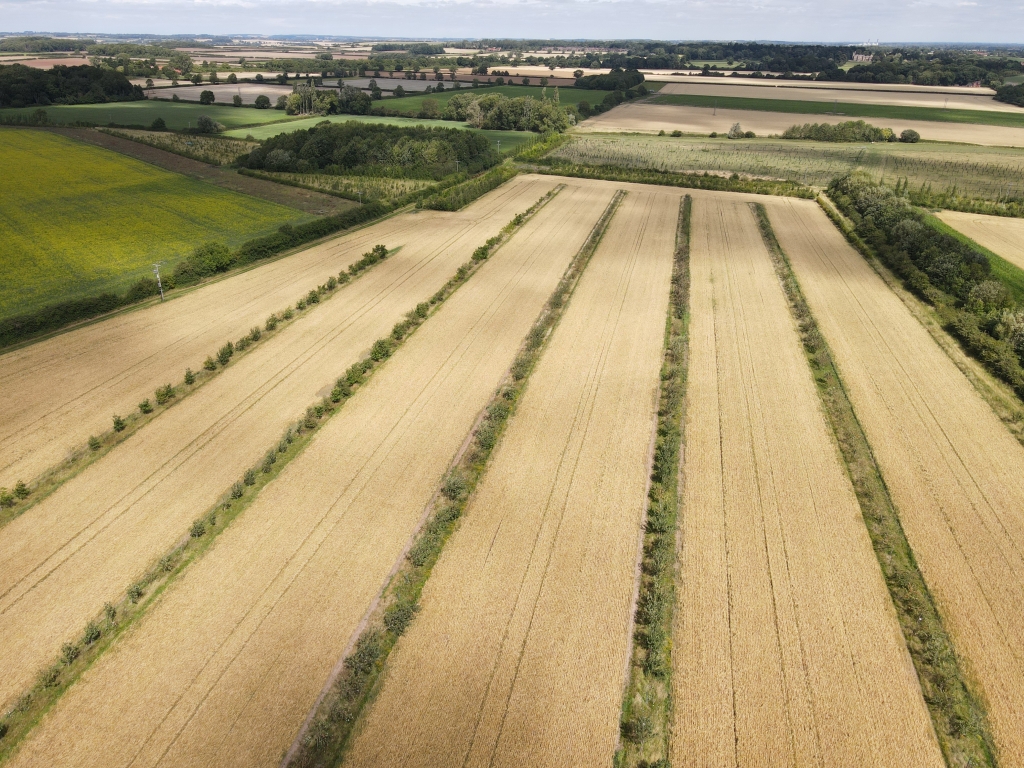
Part of an arable farm is utilising the agro-environment as well as you can, and we decided areas like corners of fields were being unproductive, so when we looked at the whole woodland creation plan we wanted to carry out, we decided we’d take a lot of the corners and less productive areas out and try and create corridors that insects and animals could migrate around.
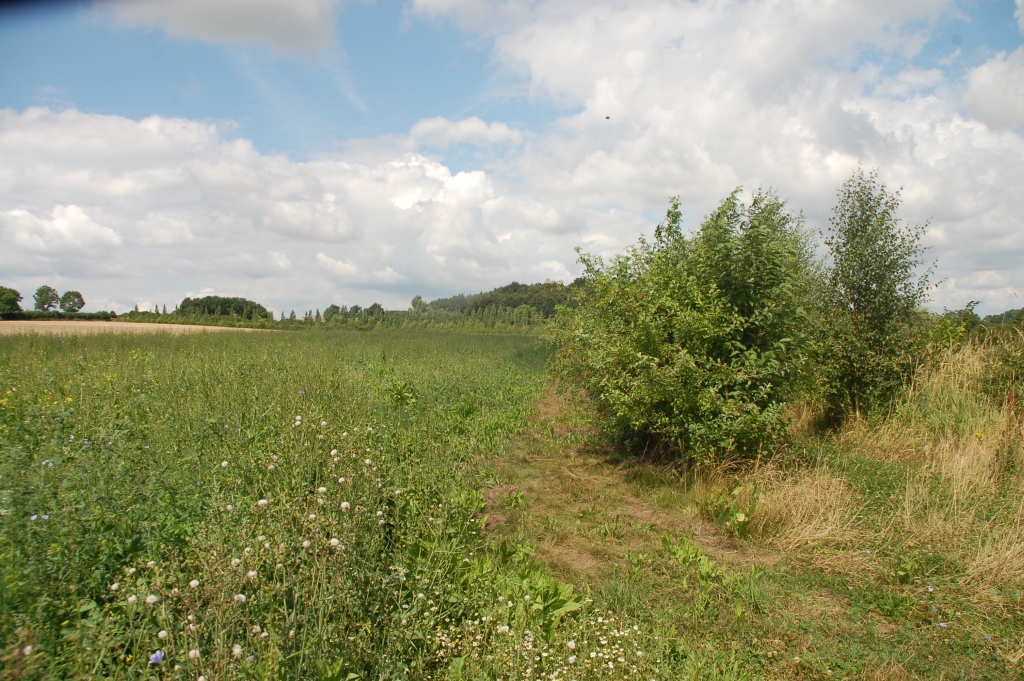
We planted the trees either straight into the grass or into arable or wildflower mixes. We have also planted trees into canary grass – this provides great cover for birds (in one of our best partridge drives) as well. Because we’re not growing for the biomass in these areas, the fact that trees haven’t grown as much isn’t quite as important – the biodiversity is increasing. We have a 30-ac (12 ha) wild bird cover mix (see below) which includes kale, quinoa, and chicory), which not just benefits partridges and pheasants, but all kinds of other wildlife too, and lasts for 3 years.
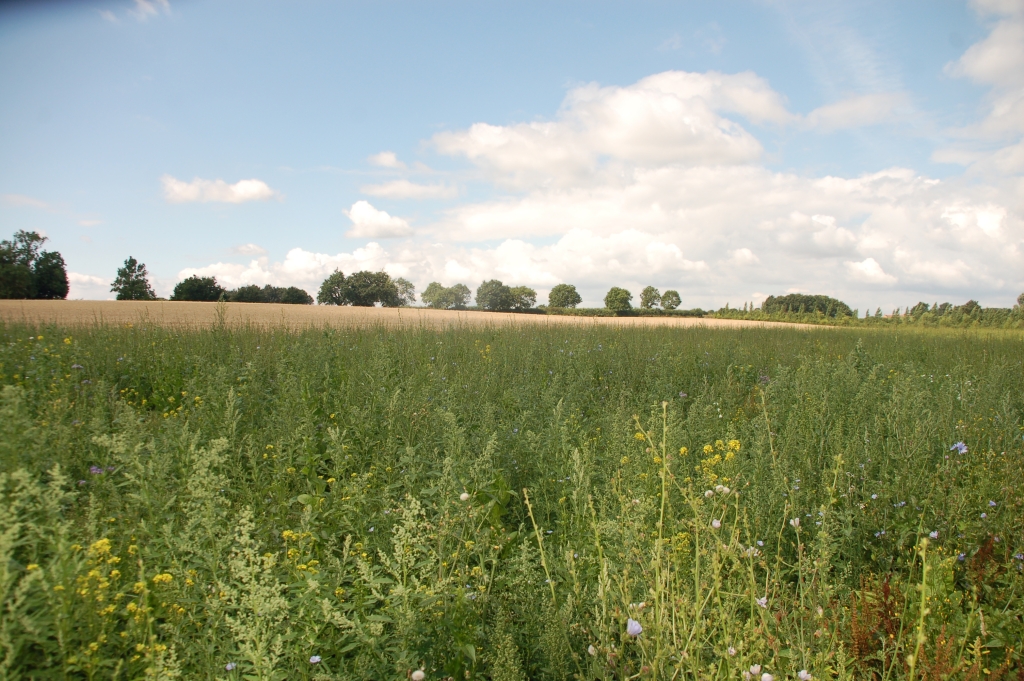
We also host a ‘Tiny Forest’ inspired by growth techniques of botanists Akira Miyawaki and Ernst Gotsch which consists of about 400 trees relatively native to Nottinghamshire (rowan, oaks, etc.) grown in 200 metres (m)2. The technique is supposed to give a kick start for trees – the idea is they complement each other for the first 2 years, by year 5 -10 the stronger trees will grow (and you have a forest that would normally take 20 years to produce), and in 50 years’ time you’ll be left with a couple of really strong trees. The principle is to make use of everything on your farm – getting the right levels of wool, straw, topsoil, coffee grinds etc. is crucial.

About 4,500 fruit and nut trees and 60 different varieties were originally planted in the agroforestry trial areas described below (with some varieties having more difficult challenges than others!).

Silvoarable (with fruit & nuts)
We have 2 fields of 15 ac (6 ha) – one planted with agroforestry; about 740 trees and a wheat or bean crop between rows, the other monoculture control field just with wheat. They were planted in 2014 with beat up (any failed trees replaced) in 2016.
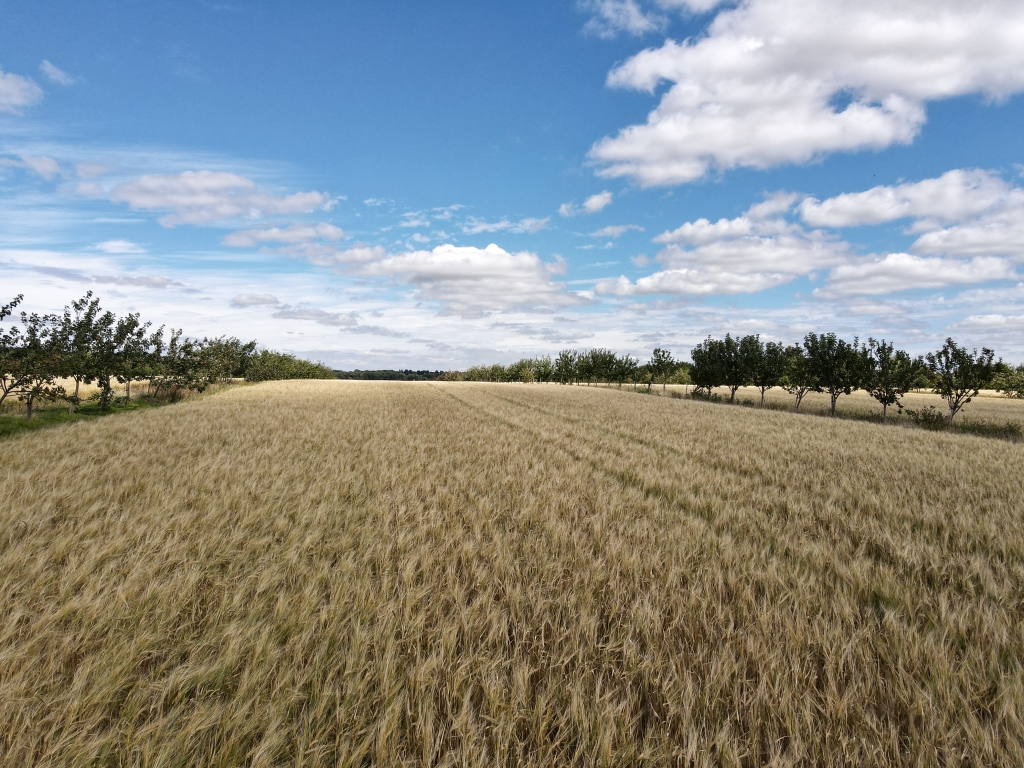
System layout & crop species
The agroforestry consists of 5 different alleyways of trees every 27 m. After every 24 m of arable crop, there is 3 m of wildflowers, grasses, then a row of trees. The 24 m of arable crop allows for the width of the sprayer and fertiliser spreader (our combine header is 6 m wide).
The tree rows are about 230 m long, and about 3 m wide, with the 24 m in between them allowing for turning circles of the machinery. The trees are predominantly apples, there are also walnuts and sweet chestnuts. We have 20 different varieties – heritage apples (such as James Grieve), elderflower, and different fruit and nuts on the final row.
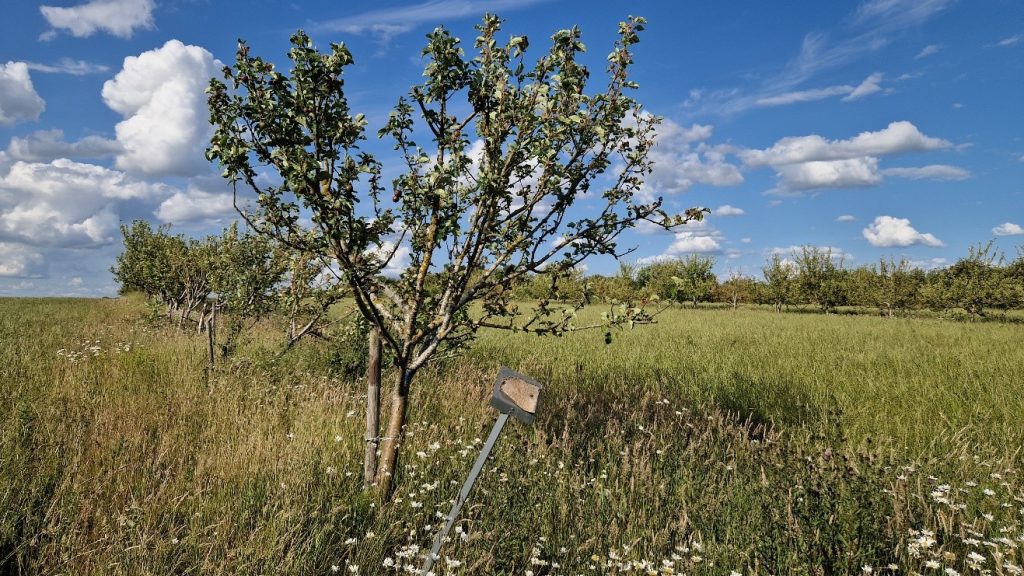
Management
There are three key time of the year; typically, winter is all hands to the deck, with maintenance including manual tree pruning, summer is more general tree care and getting ready for the harvest, and September is the key harvest and production season (we harvest by hand). We have lots of volunteers who help with the pruning etc. which is good for the social element.
Challenges
We do get a lot of wind coming through and have had problems with wind damage. We severely pruned the trees in 2021 make them shorter and more robust. Despite this, we have found that many of the trees in the silvoarable area have begun to lean quite drastically, and we think this is because their roots have grown laterally rather than vertically, providing a less secure anchor. This is probably due to the way that the trees were planted, and something we can learn from for the future.
Our biggest challenge is making sure the trees are in good health and in good condition, and the second is not using pesticides – some varieties of apples get blackspot. Overall, we have learnt it is best to keep it simple!
Monitoring and long-term plans
We are monitoring over a 20-year period to look at economic, environmental and social benefits of the 2 fields and how they compare and help give evidence to other farmers. Research being carried out is looking at how agroforestry can help farmers diversify and use trees as a way of helping with their economic and environmental return (improving habitats) and social return – getting more people out on to the farm. We are comparing the return we get from yields and monitoring environmental and social benefits. We are also going to measure differences in yield of wheat crops.
The trees take out 1 ac of land – in 1 ac of wheat. We can usually grow about 3 tonnes of wheat – £170 a tonne. We rely on subsidy payment to give us a margin that allows us to make money out of the field. We could probably make about £50 – £80 an acre out of each of the arable fields – so the trees have to produce about £80 worth of apples. We are looking also to add value with cider and cider vinegar. We are currently working with a lovely bread maker called Nottingham Mill Co-op – a community flour mill and bakery kitchen space based in Nottingham city centre.
Another silvoarable project that we have implemented is a working wood (a short rotation coppice) of hazel and willow on another 15-ac (6-ha) field, which was created with the aim of becoming more self-sufficient, providing ‘biomass’ for our biomass energy system and natural resources for craft sessions and hedge laying. We began the planting in January 2022 with 10 m strips – to give protection for wheat going into the field. We aimed for 4 rows of productive trees then 1 row of protecting trees, balancing the need for sufficient space for turning circle of tractors while still ensuring we have the right number of rows. 3 years on, we have not yet reached the biomass production stage, but are successfully harvesting natural resources for hedge laying.
Silvopastoral (edible woodland)

We decided to plant about 17 ac (7 ha) of edible woodland on arable land, growing trees and grass at the same time (see area behind the silvoarable). The woodland was planted in 2 different growing years – 2016-17 on one side, 2017-18 on the other, and in total 2,496 fruit and nut trees and shrubs have been planted. The project has been supported by the local community, for example by volunteers planting trees. The idea is that the woodland becomes a community resource, offering volunteers the chance to plant, tend and harvest the crops as well as have a say in how they should be used, or where they could be sold.
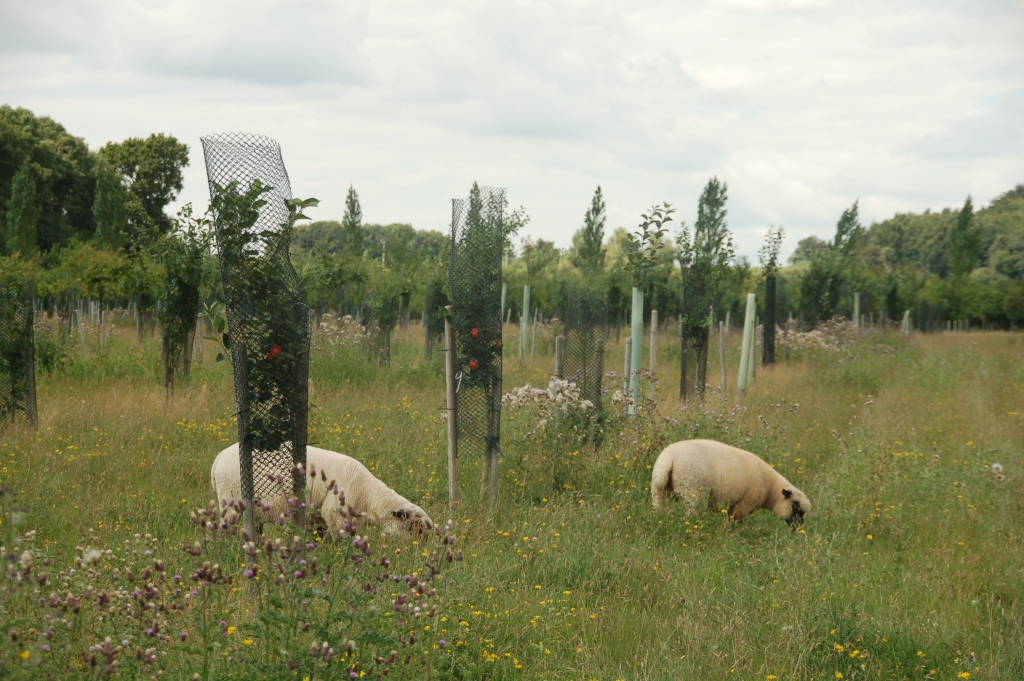
Within the woodland we now have about 50 pedigree Shropshire sheep. This is very much a trial site and was partly motivated by the desire to leave some of the land to a community-led agricultural scheme. We are going to review our livestock in the autumn and explore how to best go forward, while looking for a partner to help support this part of the business.
System layout and crop species
It is a 15-ac (6-ha) field with grass margins. The trees were laid out in a design to mimic a natural woodland. The trees produce edible products – apples, pears, cherries, damsons, plums, apricots, quince, lime, elder, whitebeam, mulberry, sea buckthorn, gooseberries, raspberries, blackcurrants, wild service tree, Japanese silverberry, rowan, dog rose, medlar, hawthorn and crab apple were all originally planted.
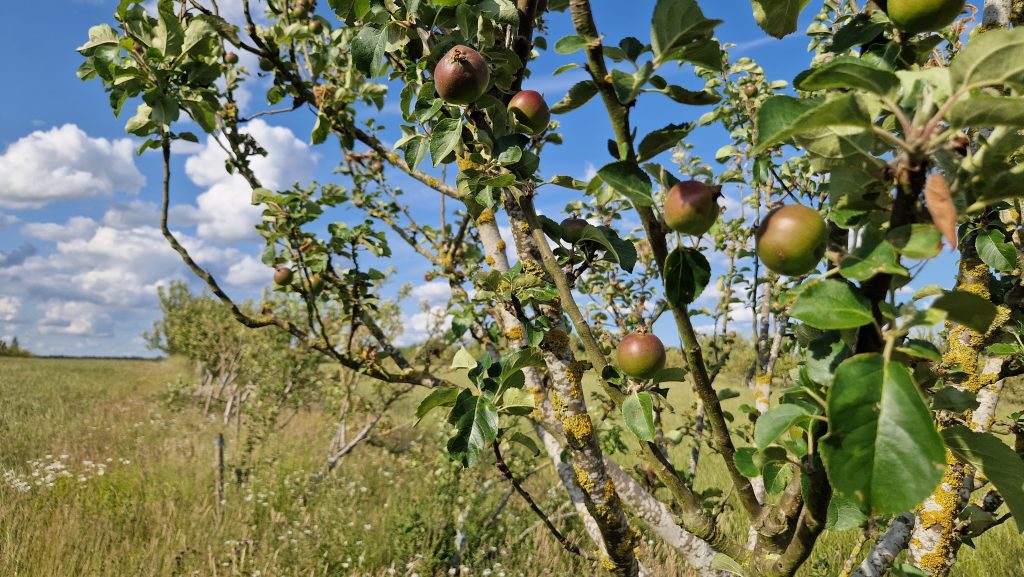
The nut trees include sweet chestnut, walnut, hazel and almond. Everything will produce a crop as well as bringing benefits to the soil and wildlife. Where possible we have used native and heritage trees, this has involved learning from local experts and practices that have been passed down from previous generations. The Woodland Trust have provided advice on species, the scheme design, and have subsidised the trees.
We see great potential and value in growing ‘novel’ crops like autumn olive and sea buckthorn, as these niche crops offer UK farmers opportunities to remain competitive and profitable in an increasingly globalised commercial food system. Sea buckthorn is one of the few plant-based sources of both Omega-3 and Omega-6 – essential fatty acids that play a vital role in brain development. In line with our health focus, we are also looking at ways that we can use our agroforestry products to create natural remedies, balms and tinctures.
Since the start of the project, we have had to replant and change some of the tree species and varieties slightly. This is both due to the success/ failure of certain species, and lack of availability from nurseries who are struggling to cope with the increased demand for heritage varieties in recent years.
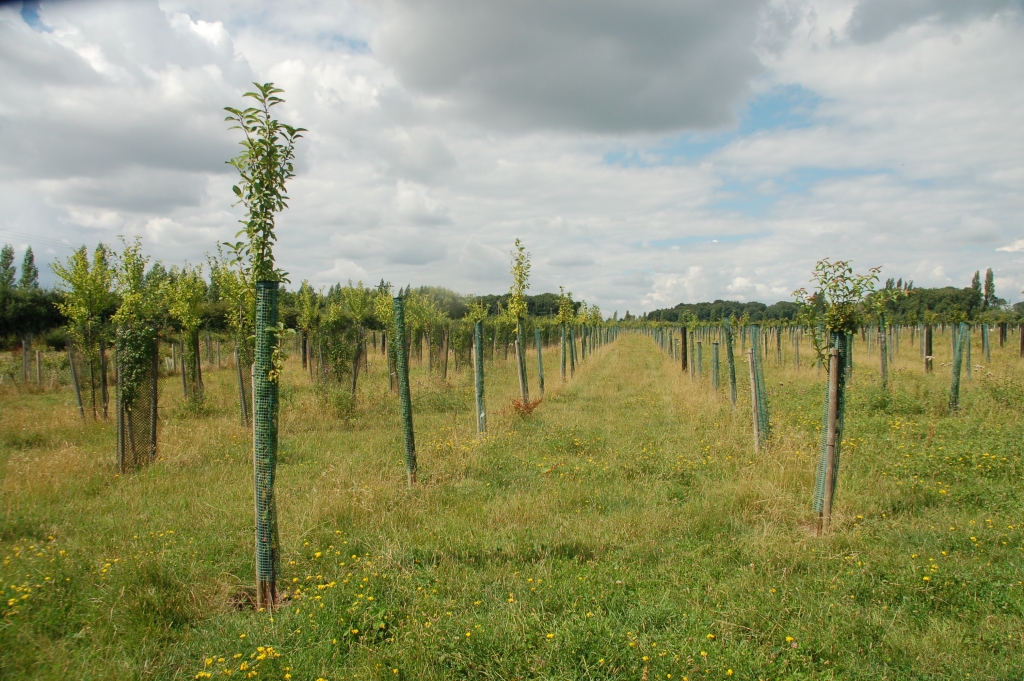
Management and challenges
We have had some very testing times – the biggest task has been keeping the trees alive and keeping the sheep alive at the same time! Guards have been a huge problem – tubex ones didn’t allow the trees to breathe – the open ones weren’t tall enough.
Over the past few years, the changing climate is presenting more and more challenges for our agroforestry, with periods of extreme temperature and low rainfall occurring with increased frequency. It can be hard to keep up with the demand for watering during dry periods, especially for saplings and newly planted trees.
At the start of the project, we lost 40% of everything from apples, pears, damsons, and apricots to sweet chestnuts, because of the severity of the weather. We had two months of flooding followed by the driest summer ever, then had issues with the sheep grazing – so we decided to keep them out for a year and top the grass instead. But because we topped it and allowed the grass to grow up, the voles moved in – heaven! 70% of the area of apple trees was eaten. The Woodland Trust were keen to continue to see the project through, and have thankfully agreed to support the replacement trees, with the right tree in the right place being a clear objective.
We are a very collaborative team, constantly developing and refining our approaches. Due to the complexities in these system we find flexibility and adaptability the best approach.
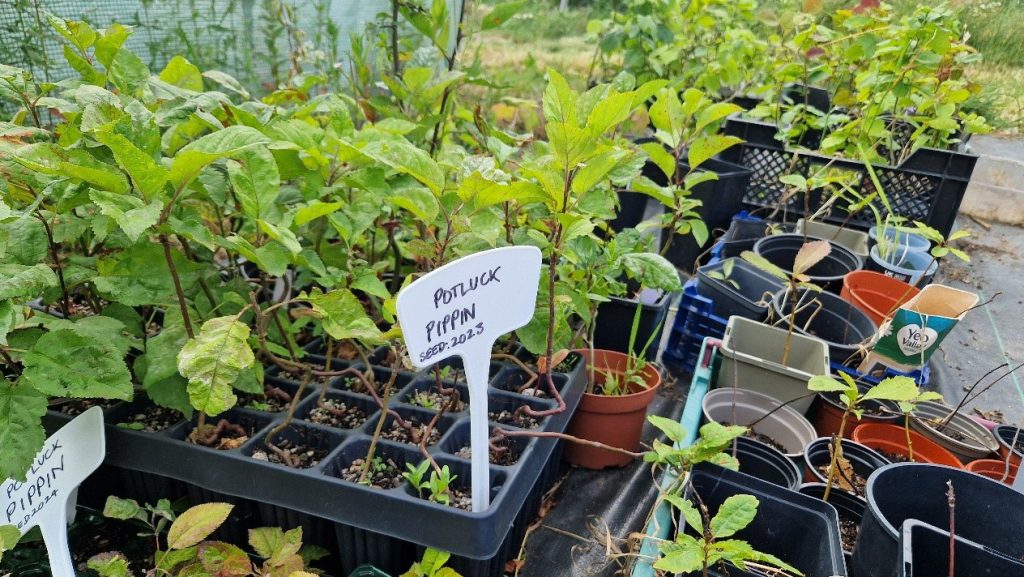
Monitoring and long-term plans
The team have been monitoring every tree… and deliberating whether it’s best to go back to the same trees we started with, or what will give us that profitability that allows us to do everything? We’re looking at apple and nut varieties. We won’t go for the sweet chestnuts again – we have lost lots of them, they can be quite hard to keep and the site just wasn’t suitable for them. The apples are starting to produce now – years 5 and 6 are when they will be really productive.
We started off with a very complex planting design – instead of all the apple trees being in one zone, then all the sea buckthorn being in another etc. they were scattered all over the place so it makes even the process of harvesting very complex. Each tree species has different maintenance and protection requirements. Even different varieties have been found to vary hugely – some have thrived, some have died. As a response to this, we are now implemented zoning in this area which has made it much easier to manage.
We hope to be able to produce woodland lamb we can sell locally. We are monitoring liveweight gains, which trees have been damaged, which are surviving etc. If we can get animals grazing successfully it will give us two bits of an income cherry – edible fruit and lamb produced in sustainable way. We recently moved a step closer to this goal, receiving funding for the purchase and installation of fencing for the area to be grazed. Fortunately, we were able to get our application in just before the Sustainable Farming Incentive programme was closed – without this money we would have not been able to cover the costs of labour and materials. The loss of such funding streams will have a real impact on other farmers in the same position.
Our long-term plan is to be able to harvest for the next 20 years – we want the community to help run it.
Research
The environmental impact of agroforestry – wind speeds, soil temperatures and rainfalls, have been measured (by the Organic Research Centre) in both fields to monitor differences. Tom Staton* from The University of Reading has been monitoring some of the insect life. He has been comparing the ‘good’ and ‘bad’ insects in the two fields; some insects can help with integrated pest management and improve crop yield and quality.
* View Tom’s PhD thesis summary here PhD thesis summary.pdf – in it he says “This project provides evidence that agroforestry farming practices, when appropriately managed, can restore farmland biodiversity and improve agricultural sustainability with comparable productivity to conventional crop production, albeit with a different set of challenges.”

Another recent research project at FarmEco explored the impact of different conservation practices on soil health, using earthworm abundance as an indicator. The study found significant differences in earthworm numbers between approaches, with minimum tillage systems showing the highest abundance compared to traditional organic and organic agroforestry methods. Read more about the study here.
A separate research project on bird species diversity, conducted from 2021 to 2023, recorded high levels of biodiversity across the FarmEco site. The findings highlight the success of FarmEco’s current land management and feeding strategies in supporting wildlife, with the report recommending the site as a valuable location for future research. You can read the full report here.
Overall benefits
- We believe trees offer a great financial, economic and social return for years to come.
- We want to be a hub for the community allowing everyone to have experiences of farming life and nature, the agroforestry is a key part of this.
- The integration of trees on the farm is allowing us to use conservation to develop nature-based solutions to climate change.
- The agroforestry contributes to us growing nourishing and delicious food to sell locally, using practices that are kind to the environment.
Motivations and future goals
Through my association with Nuffield and Stephen Briggs, I got to know the Woodland Trust and have been trying to farm with trees for over 13 years. I’m very honoured and thankful to be an Advocate for the Woodland Trust – we have advice and research being carried out, we’re making money, we’re farming with trees…

One of my main aims is to look at mitigating and counteracting the impacts of climate change on the farm. Our weather patterns are changing – with an increased severity of patterns. Another main aim is to reduce our use of insecticide through the use of trees (hence monitoring insect life is crucial).
Looking forward
We would like to see agroforestry continue to be an integral part of the farm’s DNA. We have learnt a lot through the agroforestry trials and are continuing to adjust how we deliver this strategy to make it work best for our climate and to provide maximum benefits. At the moment, we are looking at ways that we can make money from the fruit the trees are producing, which includes working with a local cider producer to repurpose our surplus or damaged apples.
A crab apple sapling insulated by sheep’s wool
Food for Health project
In recent years, I have become more aware of the connection between soil health and human health. My experiences and studies have taught me how regenerative farming practices such as agroforestry can not only benefit the land but also improve the nutrition of the food we eat. I am interested in studying how regeneratively farmed food increases wellbeing and prevents disease, and finding ways to quantify this. FarmEco is currently hosting a new Food for Health project alongside the Nuffield Foundation, which is funded by the Frank Parkinson Trust. Going forward, I will be working on developing this project alongside fellow Nuffield scholars Lucy MacLennan, Hannah Fraser and Tom Pearson, with the aim of providing an evidence base for the integration of sustainable farming and nutrition within the public health agenda.
Final reflections
Our experience of agroforestry has raised the question of what role can agroforestry systems play in a wider landscape nature recovery programme? i.e. can they become the wildlife corridors of tomorrow? Other farmers should be particularly encouraged by the potential of agroforestry to enhance natural capital and the benefits from enterprise stacking whilst improving biodiversity.
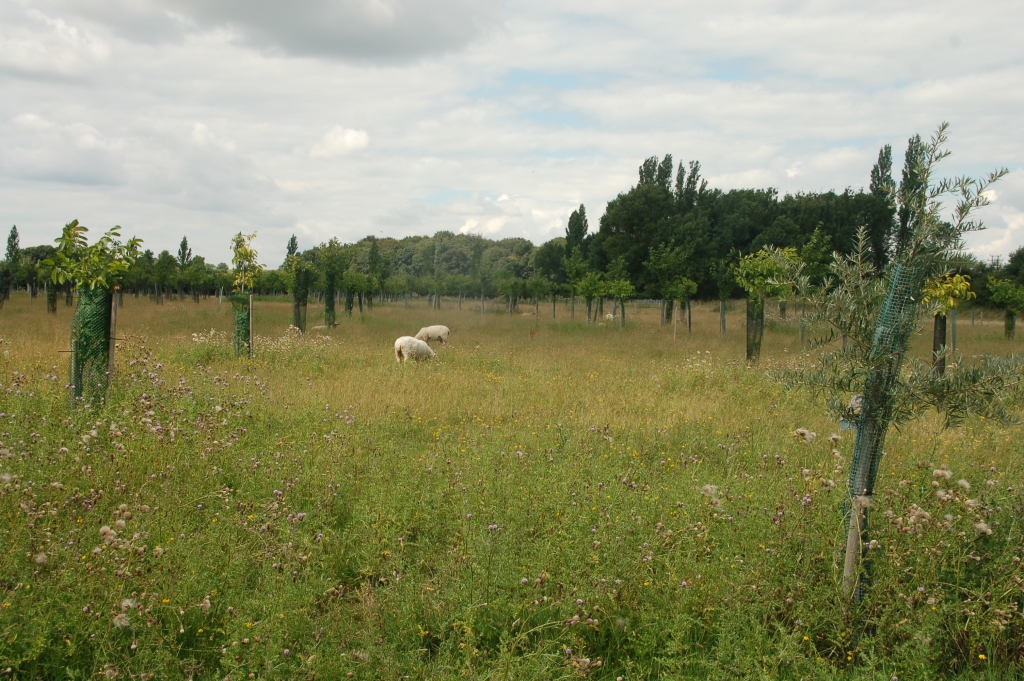
Farmer tips
- Keep it simple, start small and build year on year (a phased approach means you can learn lessons along the way). This includes the variety of trees, guarding practices, size of area and guidance provided to volunteers.
- Have a target market in mind and clearly define how it fits into the overall farm and conservation plan.
- Sheep will always get to young trees if not protected properly.
- Young trees are prone to wind and will need re-staking.
- Maintenance is a time-consuming process.
This profile was created by Janie Caldbeck (with updates provided by Alice Farmery) on behalf of the Woodland Trust
With very many thanks to David Rose and James Thompson
Header image courtesy of David Rose and FarmEco, images of the farm from above courtesy of Archie Ruggles-Brise, all other images taken by Janie Caldbeck (in August 2021) and Alice Farmery (in June 2025).
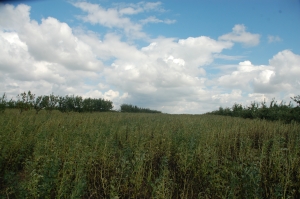
24m of arable crops inbetween tree rows
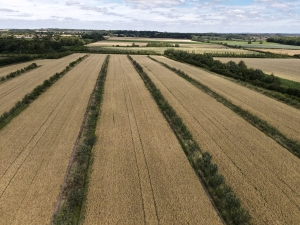
Agroforestry on Home Farm

Chicory catching the sun's rays
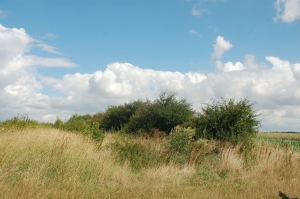
Corner of a field being utilised
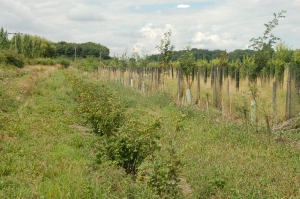
Edible woodland with fruit bushes growing on the left
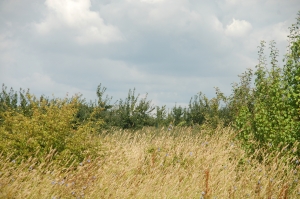
Grasses and trees in the silvoarable areas
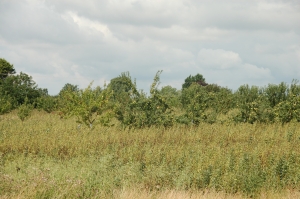
Rows of trees with beans
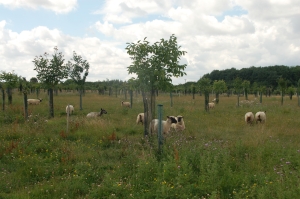
Sheep amongst the edible woodland

Sheep sheltering in the hot sun

Some of the different breeds of sheep on the farm
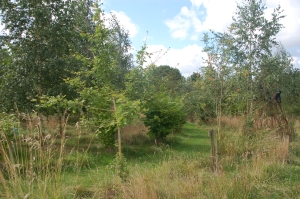
Some of the more recently planted trees on the farm

The Tiny Forest signage

Walnut tree in the foreground

Wild bird cover mix

Wool used for mulching around the base of trees in the Tiny Forest

The tree nursery at FarmEco with small saplings
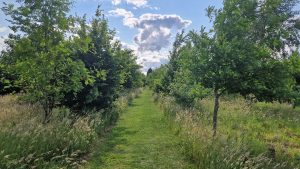
A mown grass pathway, lined either side by trees.

Trees and hedgerow at the border of a field

Fruit tree alleys behind an area of recently ploughed soil

